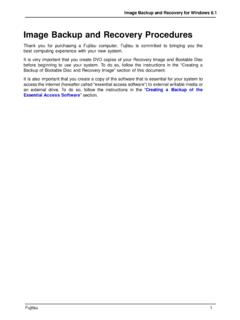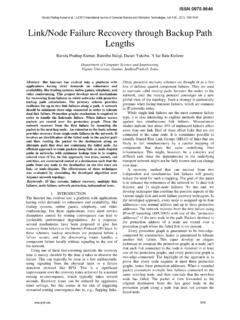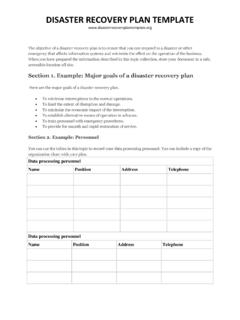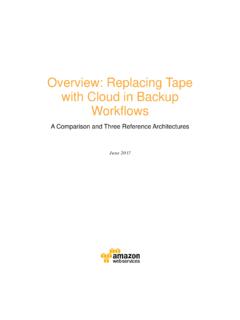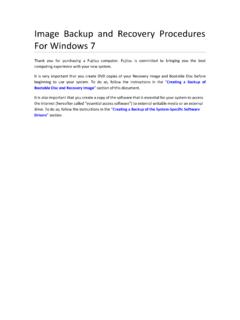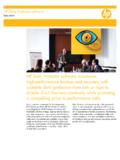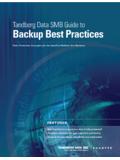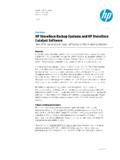Transcription of White Paper WP027005EN Disaster recovery planning - Eaton
1 Effective November 2013 White Paper WP027005 ENDisaster recovery planningDisaster recovery planningThis document provides information on how to plan for and recover from events involving electrical system outages. It is designed for use by suppliers, installers, inspectors, and electrical product users. Electrical equipment exposed to water following a storm or a flood can be extremely hazardous if re-energized, but this topic is covered in a separate NEMAT publication, Evaluating Water-Damaged Electrical Equipment , detailed at the end of this is no one-size-fits-all template for Disaster planning . The goal of this document is to provide ideas on ways to lessen the impacts of electrical system failure following a systems within a facility respond differently to losses of power. After a Disaster , power should be restored to the most critical services first, but the definition of critical changes depending on the duration of the outage.
2 Freezers and refrigerated storage may be critical systems, but once the contents reach a certain temperature and are lost, other loads within a facility may become more to sort out these priorities during the chaos that follows an event makes decision-making more difficult. Eaton recommends that this document be used as a guide for a planning session prior to an actual emergency. With established emergency procedures, the consequences of the loss of electrical power can be minimized if a Disaster employees so they know what to do. Make emergency preparedness part of the culture of an Disaster Obtain a qualified first-response service provider with trained and experienced personnel for the equipment you have at your facility. Spend the time to identify and meet with those service providers who could be contacted for Disaster support.
3 Research their capabilities. Make sure they have toured your facility and have identified critical areas. Recognize that for widespread disasters like hurricanes, both your employees and those working at your support organizations may be affected. Make sure the provider you select can source people and materials from out of the area if necessary. Perform a pre-crisis risk mitigation audit to estimate the potential impact of credible Disaster scenarios and to identify ways of minimizing vulnerability in the event of a Disaster : Perform a critical load audit to identify all loads that require backup power (which may be more than what is actually backed up today). Identify consequences of potential natural (flood, tornado, hurricane, and earthquake) and man-made (terrorist, human error within organization) threats.
4 This analysis should take into account physical surroundings ( , proximity to rail, air, port, or highways) and include financial impacts resulting from the loss of equipment. Outline consequences of loss of electricity (computer failure, loss of access, contamination, trapped persons, chemical release, and so on) with varying durations of outage. Have a contingency plan to deal with each consequence ( , manual key entry backup to electronic locks).otee:NPre-crisis audits provide the additional benefit of potentially identifying internal problems (remember that not all problems are caused by external events) that could cause issues (storage blocking equipment access and/or escape routes, missing breaker racking or lifting tools, missing drawings, and so on). Conduct a safety audit and establish procedures to ensure injury-free remediation.
5 Ensure regulatory compliance awareness, including Sarbanes-Oxley and OSHA requirements. Identify all critical documentation and create a plan to store this information so that it can be accessed off site, in one or more safe locations (do not assume that cloud communications will be available in all Disaster scenarios).Eaton1000 Eaton BoulevardCleveland, OH 44122 United 2013 EatonAll Rights ReservedPrinted in USAP ublication No. WP027005EN / Z14555 November 2013 Eaton is a registered trademark. All other trademarks are property of their respective Paper WP027005 ENEffective November 2013 Disaster recovery planning Consider adding local electrical power generation. This can take the form of: Permanent on-site local generation Highest cost, but highest assurance because there is no need to rely on a rental company s generator when you need it.
6 Keep in mind that this increases responsibility to you to ensure that the system is functioning. A common solution is to contract out maintenance to a qualified engine dealer, typically to the one from which the generator was purchased. Don t forget to contract with fuel providers for fuel delivery because normal fuel delivery will likely be affected after an event that strikes a wide area. Adding provisions for temporary power hook-up. Opening and working on electrical equipment including connecting an emergency generator can only be done by trained, certified professionals. Remember that during times of emergency, trades people will be in high demand and short supply as the hard work of restoring power begins. Consider having provisions already installed to allow the possibility of simply plugging in a backup generator.
7 Alternative energy Solar energy systems typically are designed to operate when utility grid power is available and automatically shut down when utility power is lost. However, in times of emergency, electrical power is highly desirable. Meet with your solar installation provider or a qualified engineering service provider to explore ways of configuring local alternative energy sources into an island or microgrid on an as-needed basis. This may involve adding protective devices or devices to automatically shed lower priority loads (because alternative energy is rarely sized to power an entire building s load). Identify sources of equipment reclamation, life extension, and/or replacement with full manufacturing capabilities. These sources must be certified for the equipment that is installed. Because many facilities are older and may include electrical equipment from a variety of electrical vendors, look for sources that have the certification or other demonstrated proficiency to repair, renovate, and/or renew the electrical equipment installed at your facility.
8 Make sure your contracted support organizations have expertise in staging support equipment including generators, replacement electrical equipment, and satellite communication networks. Develop a plan for survival and support accommodations for your in-house crisis response team, and ensure that your contracted support teams have done so as well. Food, water, and sleeping accommodations may be in short supply, so make sure that your support teams can sustain themselves. If you have a radio communication system, ensure that it will be operable following an electrical system failure. Typically, this involves supplying power to chargers as well as repeaters. Document and save the list of equipment installed (brand, model, and serial number), one-line diagrams, device settings, and software (both vendor provided and user custom) at your facility.
9 Update the list when you buy or change equipment or settings. Make sure new staff is trained on this procedure. Have clear responsibilities as to who is responsible to keep the data after Disaster Depending on how widespread the Disaster , recognize that failure of communication systems may prevent you from contacting service providers. Consider arranging with those providers to check in with you in case of a wide area event. Execute your Disaster recovery plan. Mobilize Disaster recovery team, each with assigned tasks. Team will include both internal personnel at your company as well as external contractors. Use established team leaders to triage (prioritize) tasks. Consider outsourcing project management for specialty items such as electrical equipment repair/restoration. Flood waters conduct electricity.
10 Entering a flooded building, especially rooms containing electrical equipment, is dangerous. Only trained personnel skilled in operating in this environment should enter such a facility. Whether or not you have done any planning , once a Disaster hits, don t panic. Choose electrical service providers carefully. While qualified service personnel may be in short supply following a wide area Disaster , be careful in your rush to find support. Hire only qualified service providers. Several manufacturers of electrical equipment have programs where electrical service providers are certified by the manufacturer. Review their recommendations by visiting manufacturers websites. A listing of electrical equipment manufacturers is available at Once you have recovered from a Disaster , spend time to review what worked, what did not, what could have been done differently, and what could have been prevented.










